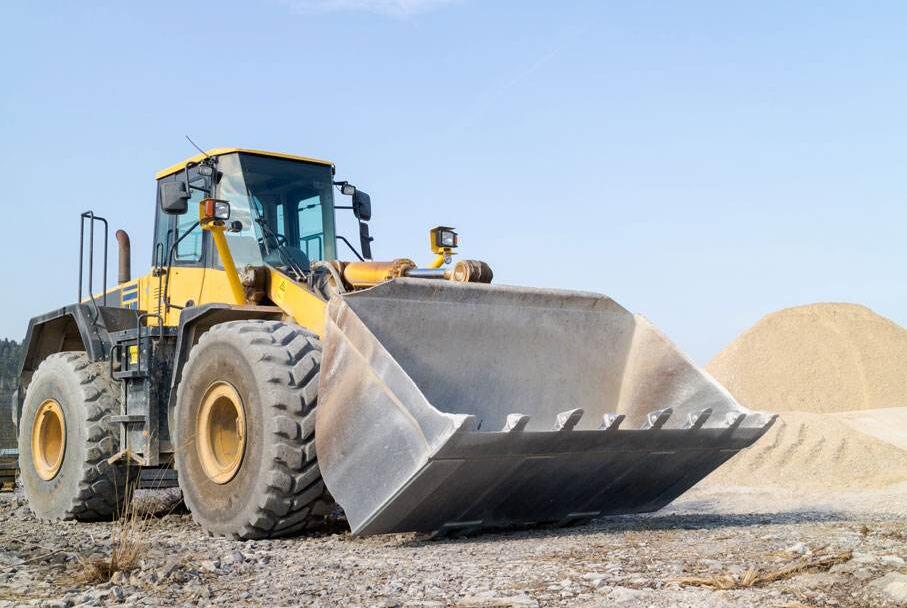

Classification of bulldozers
(1) according to the power of bulldozer engine, it can be divided into three categories: small bulldozer (below 37 kW), medium bulldozer (37-250 kW) and large bulldozer (above 250 kW).
(2) according to the running mode, the bulldozer can be divided into two types: crawler type and tyre type.
The crawler bulldozer has good adhesion, large tractive force, small ground pressure ratio, strong climbing ability and can adapt to the harsh working environment. Crawler type bulldozer has superior performance and is the key development model of bulldozer. The tyre bulldozer has the advantages of fast driving speed, good maneuverability, short cycle time, convenient and rapid transfer and no damage to the road surface. It is especially suitable for urban construction and road maintenance projects. In recent years, the production cost of tire bulldozer is low and maintenance is convenient. However, the adhesion performance of the tyre bulldozer is far worse than that of the crawler bulldozer. The driving wheel is easy to slip during the construction in the soft and humid site, which reduces the production efficiency. In serious cases, it may cause the vehicle to sink or even fail to construct. In the mining and other harsh conditions, if the tire bulldozer encounters hard and sharp rocks, it is easy to cause sharp tire wear, so the use of the tire bulldozer is limited.
(3) according to the transmission mode of bulldozer, it can be divided into four types: mechanical type, hydraulic mechanical type, full hydraulic pressure type and electrical transmission type.

The bulldozer with mechanical transmission has the advantages of reliable operation, simple manufacture, high transmission efficiency and convenient maintenance; however, the operation is laborious and the adaptability of the transmission device to the load is poor, which is easy to cause engine flameout and reduce the operation efficiency. Mechanical transmission has been less used in large and medium bulldozers.
Hydro mechanical transmission is the main transmission form of modern bulldozer. It adopts the combined transmission device of hydraulic torque converter and power shift gearbox, which has the ability to automatically adapt to the change of external load. The engine is not easy to stop, and it can shift under load, reduce the number of shifts, operate easily and flexibly, and work efficiently. The construction experience proves that the production efficiency of the bulldozer with Hydro mechanical transmission is about 50% higher than that of the bulldozer with the same power. The disadvantage of hydro mechanical transmission is that the torque converter is easy to generate heat in the working process, which reduces the transmission efficiency; at the same time, the transmission device has complex structure, high manufacturing accuracy, increased manufacturing cost, and brought inconvenience and difficulty to maintenance.
The transmission device of the full hydraulic drive bulldozer is compact in structure, easy to operate and can realize the original turning. By using the low speed and high torque hydraulic motor drive, the traction characteristic curve can be obtained, and the engine speed can be stabilized under different load conditions, and the engine power can be fully utilized. Hydrostatic drive can realize automatic stepless speed regulation, smooth operation and no impact. However, due to the high manufacturing accuracy of hydraulic components, especially the difficulty of manufacturing low-speed and high torque hydraulic motor, which increases the manufacturing cost, and the poor durability and reliability, the maintenance is difficult, so the bulldozer with full hydraulic transmission is rarely used at present.
Driven by electric motor, it has simple structure, reliable operation, no environmental pollution and high efficiency. This kind of bulldozer is generally used in open pit mining or underground operation. Due to the limitation of electric power and cable, the application range of the teletype bulldozer is greatly limited.
(4) according to the working environment of bulldozer, it can be divided into three types: ordinary type, amphibious type and underwater type.
The ordinary bulldozer has good versatility and can be widely used in various earthwork construction operations; the amphibious bulldozer is mainly used in shallow water or swamp areas, and also can be used on land. When diving into the water, the engine must be intake and exhaust through the air duct extending out of the water surface, and remote control and operation shall be carried out through the radio. The deep-water bulldozer is suitable for submarine diving operation, air intake and exhaust of air duct, remote control and operation by radio. The deep-water bulldozer is suitable for submarine diving operation and equipped with auxiliary engineering ship to provide power and drive the underwater bulldozer through cable.
(5) according to the installation mode of the bulldozer plate, it can be divided into fixed type and rotary type.
The fixed type is also called the straight shovel type. Because the angle of the bulldozer plate is not adjustable, this method is only used on the small bulldozer now.
Because the angle of the rotary bulldozer can be adjusted, the oblique and side shovel operation can be realized, and the operation range of the bulldozer is expanded. At present, large and medium-sized bulldozers are generally rotary.
CONTACT US
PRODUCT CENTER
QR CODE
